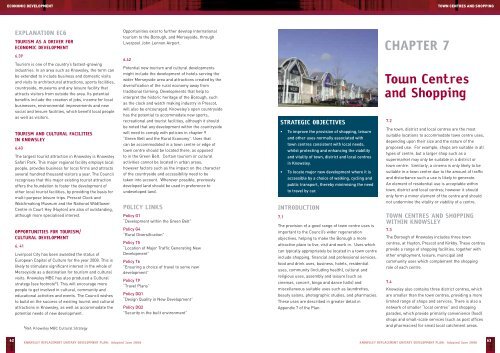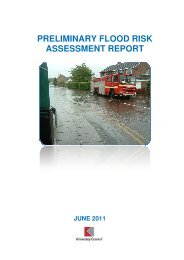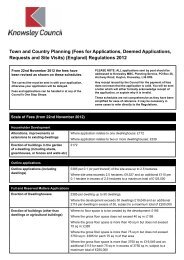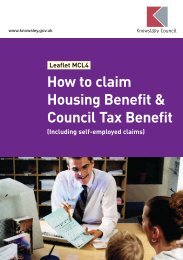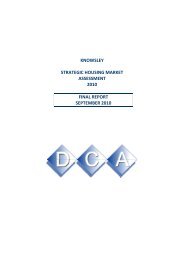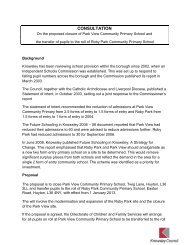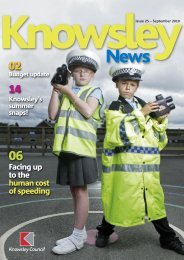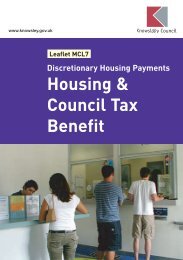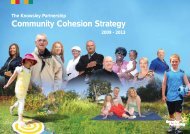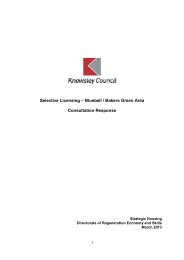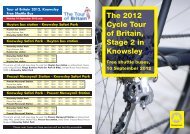Knowsley Replacement Unitary Development Plan - Knowsley Council
Knowsley Replacement Unitary Development Plan - Knowsley Council
Knowsley Replacement Unitary Development Plan - Knowsley Council
You also want an ePaper? Increase the reach of your titles
YUMPU automatically turns print PDFs into web optimized ePapers that Google loves.
ECONOMIC DEVELOPMENT<br />
TOWN CENTRES AND SHOPPING<br />
EXPLANATION EC6<br />
TOURISM AS A DRIVER FOR<br />
ECONOMIC DEVELOPMENT<br />
Opportunities exist to further develop international<br />
tourism to the Borough, and Merseyside, through<br />
Liverpool John Lennon Airport.<br />
CHAPTER 7<br />
6.39<br />
Tourism is one of the country’s fastest-growing<br />
industries. In an area such as <strong>Knowsley</strong>, the term can<br />
be extended to include business and domestic visits<br />
and visits to architectural attractions, sports facilities,<br />
countryside, museums and any leisure facility that<br />
attracts visitors from outside the area. Its potential<br />
benefits include the creation of jobs, income for local<br />
businesses, environmental improvements and new<br />
social and leisure facilities, which benefit local people<br />
as well as visitors.<br />
TOURISM AND CULTURAL FACILITIES<br />
IN KNOWSLEY<br />
6.40<br />
The largest tourist attraction in <strong>Knowsley</strong> is <strong>Knowsley</strong><br />
Safari Park. This major regional facility employs local<br />
people, provides business for local firms and attracts<br />
several hundred thousand visitors a year. The <strong>Council</strong><br />
recognises that this major existing tourist attraction<br />
offers the foundation to foster the development of<br />
other local tourist facilities, by providing the basis for<br />
multi-purpose leisure trips. Prescot Clock and<br />
Watchmaking Museum and the National Wildflower<br />
Centre in Court Hey (Huyton) are also of outstanding,<br />
although more specialised interest.<br />
OPPORTUNITIES FOR TOURISM/<br />
CULTURAL DEVELOPMENT<br />
6. 41<br />
Liverpool City has been awarded the status of<br />
European Capital of Culture for the year 2008. This is<br />
likely to stimulate significant interest in the whole of<br />
Merseyside as a destination for tourism and cultural<br />
visits. <strong>Knowsley</strong> MBC has also produced a Cultural<br />
strategy (see footnote 6 ). This will encourage more<br />
people to get involved in cultural, community and<br />
educational activities and events. The <strong>Council</strong> wishes<br />
to build on the success of existing tourist and cultural<br />
attractions in <strong>Knowsley</strong>, as well as accommodate the<br />
potential needs of new development.<br />
6 Ref: <strong>Knowsley</strong> MBC Cultural Strategy<br />
6.42<br />
Potential new tourism and cultural developments<br />
might include the development of hotels serving the<br />
wider Merseyside area and attractions created by the<br />
diversification of the rural economy away from<br />
traditional farming. <strong>Development</strong>s that help to<br />
interpret the historic heritage of the Borough, such<br />
as the clock and watch making industry in Prescot,<br />
will also be encouraged. <strong>Knowsley</strong>’s open countryside<br />
has the potential to accommodate new sports,<br />
recreational and tourist facilities, although it should<br />
be noted that any development within the countryside<br />
will need to comply with policies in chapter 9<br />
“Green Belt and the Rural Economy”. Uses that<br />
can be accommodated in a town centre or edge of<br />
town centre should be located there, as opposed<br />
to in the Green Belt. Certain tourism or cultural<br />
activities cannot be located in urban areas,<br />
however factors such as the impact on the character<br />
of the countryside and accessibility need to be<br />
taken into account. Wherever possible, previously<br />
developed land should be used in preference to<br />
undeveloped land.<br />
POLICY LINKS<br />
Policy G1<br />
“<strong>Development</strong> within the Green Belt”<br />
Policy G4<br />
“Rural Diversification”<br />
Policy T5<br />
“Location of Major Traffic Generating New<br />
<strong>Development</strong>”<br />
Policy T6<br />
“Ensuring a choice of travel to serve new<br />
development”<br />
Policy T9<br />
“Travel <strong>Plan</strong>s”<br />
Policy DQ1<br />
“Design Quality in New <strong>Development</strong>”<br />
Policy DQ2<br />
“Security in the built environment”<br />
STRATEGIC OBJECTIVES<br />
• To improve the provision of shopping, leisure<br />
and other uses normally associated with<br />
town centres consistent with local needs,<br />
whilst protecting and enhancing the viability<br />
and vitality of town, district and local centres<br />
in <strong>Knowsley</strong>.<br />
• To locate major new development where it is<br />
accessible by a choice of walking, cycling and<br />
public transport, thereby minimising the need<br />
to travel by car.<br />
INTRODUCTION<br />
7.1<br />
The provision of a good range of town centre uses is<br />
important to the <strong>Council</strong>’s wider regeneration<br />
objectives, helping to make the Borough a more<br />
attractive place to live, visit and work in. Uses which<br />
can typically appropriately be located in a town centre<br />
include shopping, financial and professional services,<br />
food and drink uses, business, hotels, residential<br />
uses, community (including health), cultural and<br />
religious uses, assembly and leisure (such as<br />
cinemas, concert, bingo and dance halls) and<br />
miscellaneous suitable uses such as laundrettes,<br />
beauty salons, photographic studios, and pharmacies.<br />
These uses are described in greater detail in<br />
Appendix 7 of the <strong>Plan</strong>.<br />
Town Centres<br />
and Shopping<br />
7.2<br />
The town, district and local centres are the most<br />
suitable locations to accommodate town centre uses,<br />
depending upon their size and the nature of the<br />
proposed use. For example, shops are suitable in all<br />
types of centre, but a larger shop such as a<br />
supermarket may only be suitable in a district or<br />
town centre. Similarly, a cinema is only likely to be<br />
suitable in a town centre due to the amount of traffic<br />
and disturbance such a use is likely to generate.<br />
An element of residential use is acceptable within<br />
town, district and local centres; however it should<br />
only form a minor element of the centre and should<br />
not undermine the vitality or viability of a centre.<br />
TOWN CENTRES AND SHOPPING<br />
WITHIN KNOWSLEY<br />
7.3<br />
The Borough of <strong>Knowsley</strong> includes three town<br />
centres, at Huyton, Prescot and Kirkby. These centres<br />
provide a range of shopping facilities, together with<br />
other employment, leisure, municipal and<br />
community uses which complement the shopping<br />
role of each centre.<br />
7.4<br />
<strong>Knowsley</strong> also contains three district centres, which<br />
are smaller than the town centres, providing a more<br />
limited range of shops and services. There is also a<br />
network of smaller “local centres” and shopping<br />
parades, which provide primarily convenience (food)<br />
shops and small-scale services (such as post offices<br />
and pharmacies) for small local catchment areas.<br />
62<br />
KNOWSLEY REPLACEMENT UNITARY DEVELOPMENT PLAN: Adopted June 2006<br />
KNOWSLEY REPLACEMENT UNITARY DEVELOPMENT PLAN: Adopted June 2006<br />
63


